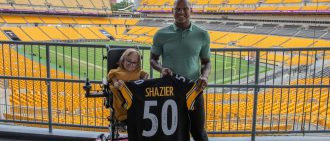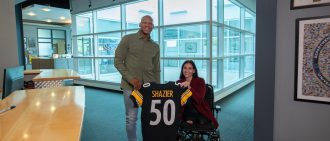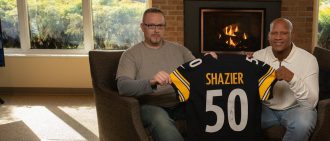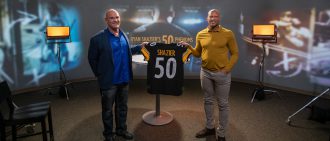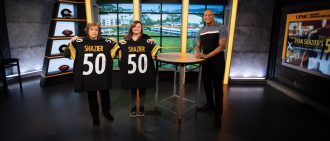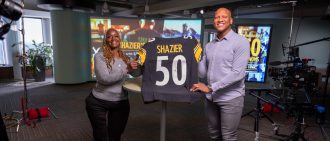Annette Waldron appreciates the simple things in life. But at one point, it looked like she might never get to do them again.
In October 2012, Annette suffered a severe traumatic brain injury (TBI) after a fall at her western Pennsylvania home. She faced long odds of survival — and even longer odds of a significant recovery.
Multiple emergency brain surgeries at UPMC Mercy saved her life. After that, years of rehabilitation helped her improve and get back to doing the things that she had taken for granted. She now enjoys household tasks like cooking and cleaning because she’s able — and around — to do them.
“Before I fell, I was always busy, busy, busy,” Annette says. “I was never home — ever. Now, I am always home. So, being able to do some simple things is really good for me because it’s helping me. I feel needed. I feel independent.”
Because of her injury, Annette still faces speaking and mobility challenges, among others. But she continues to make improvements, even a decade beyond her injury, and remains committed to this.
“The main thing I want people to learn is: Even though it could be traumatic, there’s a future to get better,” she says. “You can get better.”
Ryan Shazier's 50 Phenoms Season 4
‘We Were All in Shock’
Before her injury, Annette worked as the education director at WQED. She won multiple Mid-Atlantic Region Emmy® Awards for her projects. She was also the executive director of Wagner House, a nonprofit early childhood center that provided resources for single mothers in need. She helped create the center to honor her grandparents.
On top of her work, Annette and her husband, Glenn, had two teenage children: Christian and Abigail.
“I was always very busy,” she says. “I loved being a mother the best, but I always had numerous jobs.”
In October 2012, Annette had surgery to correct a problem with her retina. After she returned home, Glenn went to the pharmacy to pick up her prescription.
Annette says she felt dizzy but couldn’t stay seated.
“I remember I just was stubborn and had to go to the bathroom,” she says. “My daughter, at the time, was 14. She would say, ‘Mom, sit down. Mom, just sit down.’ I never did.
“And then I fell.”
Going down from the upstairs family room into the living room, Annette fell down several steps and landed on tile flooring. She suffered a traumatic brain injury as well as a broken jaw and broken wrist in the fall.
Right away, her children sprang to her aid. They called 911 and Glenn to report what happened. Glenn rushed home to find Annette unresponsive.
“She was just lying there on the floor, kind of spasming, while we waited for the ambulance to arrive,” Glenn says. “Just getting her to the hospital, it was chaos. The kids were pretty composed, believe it or not. I think we were all in shock at that point.”
The ambulance rushed Annette to the UPMC Mercy emergency department (ED), where she would need lifesaving care.
Glenn and the children followed by car, contacting other members of Annette’s family. Her older brother, Eugene Bonaroti, MD, is a neurosurgeon, and he made several phone calls to find out more about the situation.
Annette had had two separate hemorrhages. One had occurred in the cerebellum, the part of the brain that controls balance; it may have caused the fall. Landing on the hard tile floor caused a traumatic hemorrhage on the opposite side of her head. Both clots would require emergency surgery.
“I’ve done this for over 25 years now, and I’d never seen up to that point, or even since then, a similar case,” Dr. Bonaroti says. “I’ve never had that situation, where there are two hemorrhages where both were severe enough to require surgical intervention. To me, it just made the odds of her having a good outcome seem significantly less than if she’d had just one or the other.”
Emergency surgery wouldn’t guarantee Annette’s survival or recovery, but it would give her a better chance. She had a Glasgow Coma Scale score of 7; scores of 8 or below mean a patient is comatose.
The UPMC Department of Neurosurgery team performed both emergency procedures that night.
“She definitely had the cards stacked against her from the outset,” Dr. Bonaroti says. “But I think what saved the day is the whole system worked well. Everything from the ambulance crew response time, how they handled her in the field, how the ED handled her, and the rapid availability of the neurosurgical team. The whole system worked the way it’s supposed to. From that standpoint, they maximized her odds.”
Never Miss a Beat!
Join the email list and receive updates for Ryan Shazier's 50 Phenoms.
Thank you for subscribing!
You can now select the specific newsletters you'd like to receive.
You are already subscribed.
Subscribe to more newsletters in our email preference center.
Sorry, an error occurred. Please try again later.
Get Healthy Tips Sent to Your Phone!
‘Here She Is — She’s Back’
Annette spent over a month in a coma after her emergency surgeries, with her family never far from her bedside. She had a nurse who was a guardian at her bedside while she was in a coma.
Finally, after five weeks, she woke up. Although she felt some confusion at first about what had happened, her family helped her catch up.
“When I woke up, my injury was tragic, of course, but I was laughing,” she says. “I don’t know why I was laughing. I’ve always been an optimist, and I think that’s why I was laughing. But I did not know who anybody was at first. And then, all of a sudden I knew.”
Annette still faced a long road to recovery after waking up. She would need multiple types of therapy — occupational, physical, and speech. She moved to the rehabilitation unit at UPMC Mercy for the next stage of her care.
“I had to learn how to do everything again,” she says. “How to talk, how to walk, everything. I was a baby, basically.”
Annette’s therapists worked together as a multidisciplinary team to make sure Annette kept moving forward.
“We work very close, hand in hand — especially when we have our brain injury patients — to make sure we’re reaching the goals they want,” says Kirra Mediate, MA-CCC, speech-language pathologist, UPMC Rehabilitation Institute.
Mediate says she first saw Annette when she was still in her first stages of recovery at UPMC Mercy. At the time, Annette had great needs. Talking, eating, and swallowing were challenges.
The earliest days of Annette’s rehabilitation focused on basic tasks to address the biggest challenges she faced. That meant eating, breathing, speaking, and actions like mobilizing and picking up and moving items.
Despite her difficulties, Annette faced everything with a positive attitude. She says she would even tease her therapists sometimes, pretending she couldn’t do things they asked.
“I’m like my dad, and my dad was positive,” Annette says. “That’s me. That’s how I’ve always been. So, some brain injury is not going to change it. That’s how it’s always been. That’s how I’ll always be.”
Annette began to make progress. During her stay at UPMC Mercy, her team allowed her to go home for one day around the holidays. After arriving to pick her up, Glenn couldn’t find her in her room. He went looking for her and found her in the cafeteria where she had wheeled herself in her wheelchair.
“She had managed to find a drink there,” Glenn says. “I asked her, ‘Where did you get that from?’ She goes, ‘I got it myself.’ She started laughing, and I was laughing. That’s one of the main things I remember, like, ‘Oh, wow, here she is — she’s back.'”
‘Different Doesn’t Mean Worse. It Just Means Different.’
Annette spent three months in the rehabilitation unit at UPMC Mercy before getting discharged. She continued to get outpatient therapy at the UPMC Rehabilitation Institute.
Another of her brothers, John Bonaroti, is a physical therapy specialist. He and Annette’s niece would come over to her house and help her with therapy.
The rest of her family also helped with recovery, posting sticky notes throughout the house to help Annette remember things.
Recovery was a yearslong process for Annette. At first, someone had to stay at home with her at all times. And again, the recovery itself took place in slow stages. It began with basic tasks like getting up the stairs or talking.
Her mobility, her speech, and her cognition improved. As she continued to progress, she began to relearn other chores, such as cooking and cleaning.
“I do everything now,” she says. “I cook, I clean, I do laundry. But it took me a while. So, I would say from about four years, I hit a break and then everything from there was uphill.”
The recovery process had its frustrating moments for Annette. But she overcame them.
“I think the turning point for me was accepting just how it was now,” she says. “I was a different person. There are some things I would never be able to do. That’s hard for me because I’m a perfectionist — always have been. It was hard for me to learn.”
But she learned a valuable lesson.
“Different doesn’t mean worse,” she says. “It just means different.”
‘She Won’t Give Up’
It’s been almost 11 years since Annette’s initial injury. She isn’t as active as she was before her injury, but she’s plenty active as it is.
She works for her brother Eugene, maintaining the electronic medical records for his neurosurgery business. She took up scrapbooking and now puts together scrapbooks for other people.
“Sitting around and doing nothing is not in her vocabulary at all,” Glenn says. “She’s consistently running around doing things. Even now, I come home and see her crawling around the yard, pulling weeds and stuff. People who can stand and walk don’t do that.
“But that’s the thing. She won’t give up. She keeps going and going and going and won’t ever stop.”
Drawing on her previous life as an educator, Annette made it a New Year’s resolution a few years back to teach people about traumatic brain injuries. She frequently posts in online groups about TBI and recovery.
“It’s about education, teaching people what a brain injury is in the first place,” Annette says. “And the other thing is helping people, the families deal with things.
“My blessing is my family. They were everything to me. And my friends because they were there.”
She says many people think of brain injuries as they do other injuries. However, there are different types of brain injuries, and recovery is different for everyone.
“You don’t know what’s going to happen,” she says. “It’s one of those things that’s an unknown. Some people make it, some people don’t. Luckily, I did.”
There are things Annette can no longer do. She doesn’t drive. And although she used to love holding children as part of her child care center work, she can no longer do that.
She continues to take stability classes. She sometimes uses a cane but only when the ground is uneven or unfamiliar. And although her speech regressed, she is once again improving there, too.
“She doesn’t focus on her disability,” Dr. Bonaroti says. “She keeps moving forward, living life, raising her kids, and doing what she wants to do with her life.”
Dr. Bonaroti says his sister’s recovery was miraculous. Not only did she face low odds of survival, but her odds of reaching the point she is now in her recovery were under 10%.
Mediate says Annette’s positive attitude and the overwhelming support she had from her family, friends, and therapists helped her reach her goals.
“She’s amazing,” Mediate says. “When you see somebody come in with trauma and you see where they are, you hope they get to the next point and are doing as well as she’s doing, and they achieve those goals. But in the back of your head, you always have the reality of: They may not end up that way.
“She is truly a miracle to be alive, let alone to be functioning as well as she is.”
Annette says she considers herself lucky to have gotten to where she is and to have the family she has. She and Glenn married 34 years ago now, and their children are now in their 20s. They enjoy spending time together and enjoying every moment — especially the simple ones.
“The biggest thing I’m grateful for is that I’m here,” she says. “But beyond that, I’m grateful for simple things. Like movies with my husband. Seeing my daughter graduate from college. Simple things, but important to me because I can see them. Being at every single wedding or graduation.
“Family has always been important to me. It’s never going to change.”
About UPMC
Headquartered in Pittsburgh, UPMC is a world-renowned health care provider and insurer. We operate 40 hospitals and 800 doctors’ offices and outpatient centers, with locations throughout Pennsylvania, Maryland, New York, West Virginia, and internationally. We employ 4,900 physicians, and we are leaders in clinical care, groundbreaking research, and treatment breakthroughs. U.S. News & World Report consistently ranks UPMC Presbyterian Shadyside as one of the nation’s best hospitals in many specialties and ranks UPMC Children’s Hospital of Pittsburgh on its Honor Roll of America’s Best Children’s Hospitals. We are dedicated to providing Life Changing Medicine to our communities.
